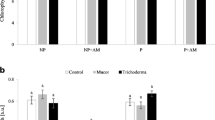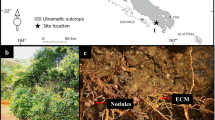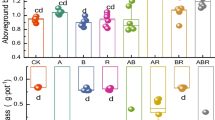Abstract
The combined effect of the arbuscular mycorrhizal (AM) fungusGlomus intraradices and the bacteriumBurkholderia cepacia onPythium ultimum was studied in a growth system with root-free soil compartments allowing examination of microbial interactions without direct interference from roots. Signature fatty acids were used to quantify individual microbial populations. Biomass and amount of energy reserves were estimated using specific phospholipid fatty acids (PLFA) and neutral lipid fatty acids (NLFA), respectively. Population density ofP. ultimum was estimated by colony forming units on selective media. Both biocontrol agents (BCAs) reduced population density ofP. ultimum. Biomass ofB. cepacia measured using signature fatty acids was inhibited by the presence of mycelium ofG. intraradices, which might explain why no additive effect onP. ultimum was found when combining the two BCAs. In conclusion, combiningG. intraradices andB. cepacia did not enhance the biocontrol efficacy againstP. ultimum.
Similar content being viewed by others
References
Andrade G., Mihara K.L., Linderman R. &Bethlenfalway G.B. (1997): Bacteria from rhizosphere and hyphosphere soils of different arbuscular mycorhhizal fungi.Pl. & Soil 192: 71–79.
Bowers J.H. &Parker J.L. (1993): Epidemiology ofPythium dam**-off andAphanomyces root rot of peas after seed treatment with bacterial agents for biological control.Phytopathology 83: 1466–1473.
Dowling N.J.E., Widdel F. &White D.C. (1986): Phospholipid ester-linked fatty acid biomarkers of acetate oxidizing sulphate reducers and other sulphide-forming bacteria.J. Gen. Microbiol. 132: 1815–182
Frostegård Å., Tunlid A. &Bååth E. (1991): Microbial biomass measured as total lipid phosphate in soils of different organic content.J. Microbiol. Meth. 14: 151–163.
Frostegård Å., Tunlid A. &Bååth E. (1993): Phospholipid fatty acid composition, biomass and activity of microbial communities from two soil types experimentally exposed to different heavy metals.Appl. Environm. Microbiol. 59: 3605–3617.
Germida J.J. &Walley F.L. (1996): Plant growth-promting rhizobacteria alter rooting patterns and arbuscular mycorrhizal fungi colonization of field-grown spring wheat.Biol. Fertil. Soils 23: 113–120.
Green H., Larsen J., Olsson P.A. &Jakobsen I. (1999): Suppression of the biocontrol agentTrichoderma harzianum by mycelium of the arbuscular mycorrhizal fungusGlomus intraradices in root-free soil.Appl. Environm. Microbiol. 65: 1428–1434.
Green H. &Jensen D.F. (2000): Disease progression by active mycelial growth and biocontrol ofPythium ultimum var.ultimum studied by use of a rhizobox system.Phytopathology 90: 1049–1055.
Hendrix F.F. &Campell E.A. (1973):Pythiums as plant pathogens.Annual Rev. Phytopathol. 11: 77–98.
Jakobsen I., Abbott L.K. &Robson A.D. (1992): External hyphae of vesicular-arbuscular mycorrhizal fungi associated withTrifolium subterraneum L. 1. Spread of hyphae and phosphorus inflow into roots.New. Phytol. 93: 410–413.
Kormanik P.P. &McGraw A.C. (1982): Quantification of vesicular arbuscular mycorrhiza in plant roots. In:Schenck N.C. (ed.),Methods and principles of mycorrhizal research, American Phytopathological Society, St. Paul, pp. 37–45.
Larsen J., Olsson P.A. &Jakobsen I. (1988): The use of fatty acid signatures to study mycelial interactions between the arbuscular mycorrhizal fungusGlomus intraradices and the saprotrophic fungusFusarium culmorum.Mycol. Res. 102: 1492–1496.
Larsen J. &Bødker L. (2001): Interactions between pea root-inhabiting fungi examined using signature fatty acids.New Phytol. 149: 487–493.
Linderman R.G. (1994): Role of VAM fungi in biocontrol. In:Pfleger P.L. &Linderman R.G. (eds.),Mycorrhizae and plant health, American Phytopathological Society, St. Paul, pp. 1–25.
Mao W., Lewis J.A., Lumdsen R.D. &Hebbar K.P. (1998): Biocontrol of selected soilborne diseases of tomato and pepper plants.Crop Protect. 17: 535–542.
Martin F.N. &Loper J.E. (1999): Soilborne plant diseases caused byPythium spp.: Ecology, Epidemiology, and prospects for biological control.C. R. C. Crit. Pev. Pl. Sci. 18: 111–81.
Newsham K.K., Fitter A.H. &Watkinson A.R. (1995). Multi-functionality and biodiversity in arbuscular mycorrhizas.Trends Ecol. Evol. 10: 407–411.
Newman E.I. (1965): A method of estimating the total length of roots in a sample.J. Appl. Ecol. 3: 139–145.
Olsson P.A. (1999): Signature fatty acids provide tools for determination of the distribution and interactions of mycorrhizal fungi in soil.FEMS Microbiol. Ecol. 29: 303–310.
Olsson P.A., Bååth E., Jakobsen I. &Söderström B. (1995): The use of phospholipid and neutral lipid fatty acid analysis to estimate biomass of arbuscular mycorrhizal fungi.Mycol. Res. 99: 623–629.
Paulitz T.C. &Baker R. (1987). Biological control ofPythium dam**-off of cucumbers withPythium nunn: population dynamics and disease suppression.Phytopathology 77: 335–340.
Ravnskov S., Larsen J. &Jakobsen I. (2002): Phosphorous uptake of an arbuscular mycorrhizal fungus is not affected by the biocontrol bacteriumBurkholderia cepacia.Soil Biol Biochem. 34: 1875–1881.
Roberts D.P., Dery P.D., Mao W. &Hebbar K.P. (1997): Use of a colonization deficient strain ofEscherichia coli in strain combinations for enhanced biocontrol of cucumber seedling diseases.J. Phytopathol. 145: 461–463.
Rosendahl C. &Rosendahl S. (1990). The role of vesicular-arbuscular mycorrhiza in controlling dam**-off and growth reduction in cucumber caused byPythium ultimum.Symbiosis 9: 363–366.
Smith S. &Read D. (1997):Mycorrhizal symbiosis. Academic Press, San Diego.
St-Arnaud M., Hamel C., Caron M. &Fortin J.A. (1994): Inhibition ofPythium ultimum in roots and growth substrate of mycorrhizalTagetes patula colonized withGlomus intraradices.Canad. J. Pl. Pathol. 16: 187–194.
St-Arnaud M., Hamel C., Vimard B., Caron M. &Fortin J.A. (1997): Inhibition ofFusarium oxysporum f.sp.dianthi in non-VAM speciesDianthus caryophyllus by co-culture withTagetes patula companion plants colonized byGlomus intraradices.Canad. J. Bot. 75: 998–1005.
Tsao P.H &Ocana G. (1969). Selective isolation of species ofPythophthora from natural soils on an improved antibiotic medium.Nature 223: 636–638.
Walley F. L. &Germida J.J. (1997): Response of spring wheat (Triticum aestivum) to interactions betweenPseudomonas species andGlomus clarium NT4.Biol. Fertil. Soils 24: 365–371.
Author information
Authors and Affiliations
Corresponding author
Rights and permissions
About this article
Cite this article
Larsen, J., Ravnskov, S. & Jakobsen, I. Combined effect of an arbuscular mycorrhizal fungus and a biocontrol bacterium againstPythium ultimum in soil. Folia Geobot 38, 145–154 (2003). https://doi.org/10.1007/BF02803147
Issue Date:
DOI: https://doi.org/10.1007/BF02803147




